
Coriander Honey
Quick Access :
General information
General
Information :
Information :
Coriander is an annual soft plant which grow up to 50 cm (20 in) tall. We all know it as a spice, using it in our cuisine, either for the leaves or the seeds. The whole plant is edible.Coriander Honey is a sweet, herbaceous honey, with a medium-strength sweetness. The aroma is very mild, with sweet, slightly citrus notes, similar perhaps to lemon oil. Bees produce honey from the sugary secretions of Coriander flowers (floral nectar) or from secretions of other insects (such as honeydew by regurgitation, enzymatic activity, and water evaporation.).One of the most important properties of coriander honey is its antibacterial effect.

Coriander honey is classified by the floral source of the nectar from which it was made. Coriander honey has many healing properties. This honey strengthens the stomach’s work, helps digestion and treats intestinal disorders.
Product benefits
Coriander Honey
Benefits :
- Helps to balance blood sugar
- Enriching in immune-boosting antioxidants
- Having a benefits on heart health
- Protecting brain health
- Promoting digestion
- Promoting gut health
- Fighting infections
- Protecting your skin
- Being easy to add to your diet
- Being the best cure of constipation
- Protecting the liver
- Preventing nausea
- Having activated in blood circulation
- Stimulating memory
- Considering as bactericide and fungicide products
- Regulated insulin levels
- Balancing Cholesterol level
How to Produce
How To
Produce :
Today, beekeepers use various methods to extract honey from honeycomb. Some methods drain the honey while preserving the wax, while others melt or otherwise manipulate the wax to remove and separate out the raw honey. Small-scale beekeepers usually stop in this step and sell honey in its raw state, but most mass producers of honey sold in supermarkets take the process a step further.

![produce 2]-min produce 2]-min](https://fara-food.com/wp-content/uploads/2020/02/produce-2-min-1.jpg)
Coriander Honey is produced by bees collecting coriander flower nectar for use as sugars consumed to support metabolism of muscle activity during foraging or to be stored as a long-term food supply. During foraging, bees access part of the nectar collected to support metabolic activity of flight muscles, with the majority of collected nectar destined for regurgitation, digestion, and storage as coriander honey. In cold weather or when other food sources are scarce, adult and larval bees use stored honey as food. Because of its composition and chemical properties, coriander honey is suitable for long-term storage, and is easily assimilated even after long preservation. Honey, and objects immersed in honey, have been preserved for centuries.
Packaging
Packaging :
As far as packaging is concerned, there are various options – cups, glasses, cans, buckets. We can provide Coriander honey in each quantity that our client wants, there are no limited in weight and destination or in packed.
